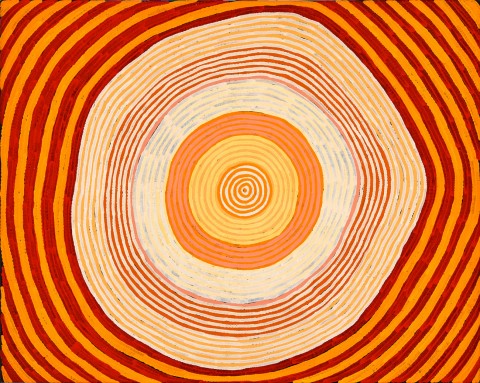PALKARULKULNGA, 2002
RONNIE TJAMPITJINPA
synthetic polymer paint on linen
122.0 x 152.5 cm
bears inscription verso: artist's name, size, and Papunya Tula Artists cat. RT0204077
Papunya Tula Artists, Alice Springs, Northern Territory
Utopia Art Sydney, Sydney (label attached verso)
Private collection, Melbourne
Ab Op Art II - Exploring the Visual Intensity of Contemporary Aboriginal Art, Utopia Art Sydney, Sydney, 28 June – July 2003, cat. 22
This work is accompanied by a certificate of authenticity from Papunya Tula Artists, Alice Springs.
Of all the artists who emerged from the Papunya movement, the paintings of Ronnie Tjampitjinpa are some of the most recognisable. Often composed from one or more geometric forms enlarged to monumental size and highlighted in alternating bands of bright colours, the simplicity of his painting belies the complexity of that which is depicted. Tjampitjinpa offers glimpses into the expansive and diverse geography that surrounds his homeland and fragments of the multi-layered stories of the Tingari – a mythical group of Ancestors who moved across vast stretches of the Western Desert sharing law and creating and naming places. One of the youngest men to begin painting at Papunya in 1971 – 72 and one of the founders of the hugely influential Papunya Tula Artists group, Tjampitjinpa began painting under the tutelage of Uta Uta Tjangala and was encouraged by school teacher Geoffrey Bardon. Tjampitjinpa’s painting output for Papunya Tula during the 1970s was limited as his focus at that time was directed towards the outstation movement and the return of the Pintupi to their homelands in the Western Desert. With the establishment of Walungurru (Kintore) in 1981, Tjampitjinpa could now turn his attention to his art, and he soon emerged as one of the major painters of the movement. Seeking to establish himself as a serious painter, Ronnie took an independent direction and began to expand various elements of the Pintupi painting lexicon, increasing them in size and proportion, resulting in what Vivien Johnson described as ‘the bold, scaled-up, linear style that came to dominate many of the Walungurru painters’ work during the 1990s’.1
Ronnie Tjampitjinpa’s later paintings are reductive and vivid optical works that pulsate with energy and this distinctive aesthetic is exemplified by Palkarulkulnga, 2002. In this painting, Tjampitjinpa has taken a single component from his visual lexicon, the roundel. Comprised of ever-larger ovoid bands of alternate colours that radiate out from the centre, the roundel has evolved into a single monumental form. This upscaled geometric element representing just one part of the Tingari story, is the result of two decades of refinement by the artist in charting the vast terrain of the Western Desert in his own deft visual language.
The related story is part of the Tingari cycle and tells that in mythological times a man of the Tjakamarra kinship subsection camped at Palkarulkulnga, a place of sandhills and spinifex to the eastern side of Wilkinkarra (Lake Mackay) in the northern Territory, close to the Western Australian border. While camped here, the Tjakamarra man was spinning hair to make a hair-belt to be worn in future ceremonies.2
Ronnie Tjampitjinpa has been the recipient of a number of awards, including the 1988 Alice Prize. His first solo exhibition was held at Gallery Gabrielle Pizzi, Melbourne in 1989, and his work was included in Dreaming at the Asia Society Gallery, New York in 1988, and Australian Perspecta in 1993. More recently, an exhibition celebrating 40 years of the artist’s work was held at the Art Gallery of New South Wales, Sydney in 2015.
His work is included in various Australian and international collections, including the National Gallery of Australia, Canberra; the Art Gallery of New South Wales, Sydney; the Musée du Quai Branly, Paris; Collection Fondation Opale, Lens, Switzerland; and the Seattle Art Museum, USA.
1. Johnson, V., ‘Ronnie Tjampitjinpa’, in Perkins, H., Tradition Today, Indigenous Art in Australia, Art Gallery of New South Wales, Sydney, 2006, p. 140
2. Taken from the accompanying certificate of authenticity from Papunya Tula Artists.
CRISPIN GUTTERIDGE
